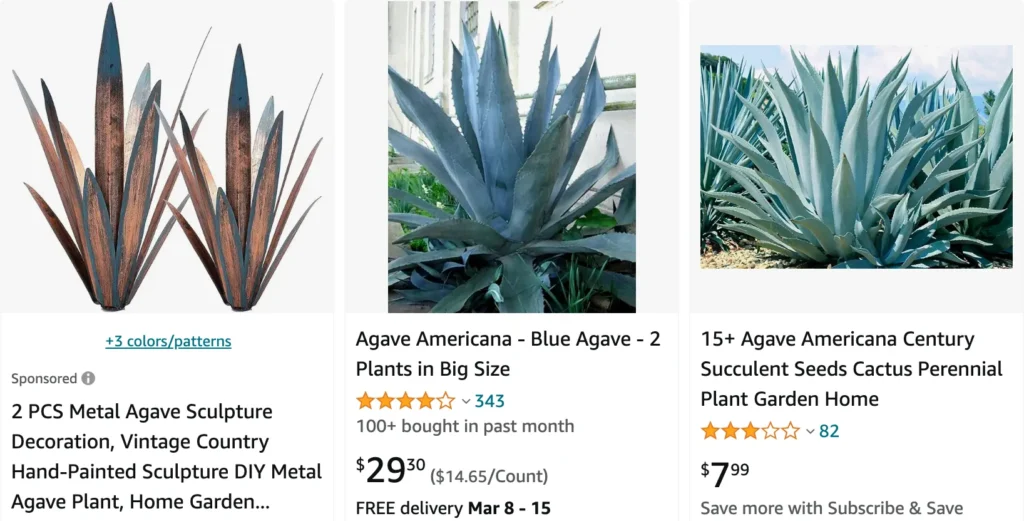

What is Agave Americana? Are Agave Americana century plants?
Agave Americana is commonly known as the century plant because of the myth that it blooms only once in a century. In reality, it typically blooms once between 10 and 30 years, depending on growing conditions, it is a species of succulent native to Mexico and the southwestern United States. It’s known for its dramatic, spiky rosette of blue-green leaves and impressive size. The plant is often grown for ornamental purposes due to its striking appearance and low maintenance requirements.
Can you make tequila from Agave Americana?
Tequila is specifically made from the blue agave (Agave tequilana), not Agave Americana. While Agave Americana can be used to produce other types of agave spirits like mezcal, it is not the traditional plant used for tequila production.
How big does Agave Americana grow?
Agave Americana can grow quite large, with leaves that can reach up to 6 feet long and form a rosette up to 12 feet in diameter. When it blooms, the flower stalk can shoot up to 20-30 feet tall.
How fast does Agave Americana grow?
Agave Americana grows relatively slowly, taking many years to reach full size. It can take anywhere from 10 to 30 years to mature and produce its tall flower stalk.
How to plant Agave Americana?
To plant Agave Americana, I select a sunny location with well-draining soil. I dig a hole twice as wide as the root ball and slightly shallower than its height to prevent water from pooling around the base. After placing the plant in the hole, I fill it with soil, making sure the crown is slightly above the soil line to avoid rot, and then water it lightly.
How to trim Agave Americana?
Trimming Agave Americana involves removing dead or damaged leaves. I use sharp, clean pruning shears and wear gloves to protect myself from the sharp leaf tips and sap. I cut the leaves close to the base, avoiding cutting into the main stem to prevent infections.
Is Agave Americana poisonous?
Yes, Agave Americana is considered poisonous. Its sap can cause skin irritation and digestive issues if ingested. Handling the plant requires caution, and it’s best to keep it out of reach of pets and children.
Do Agave Americana century plant have flower?
Yes, Agave Americana produces a tall flower stalk with numerous yellow or greenish flowers. This dramatic blooming event is a spectacular sight and marks the end of the plant’s life cycle.
Does Agave Americana die after blooming?
Yes, after Agave Americana blooms, the main plant typically dies. However, it often produces offsets or “pups” around its base that can be replanted to grow new plants.
Does Agave Americana produce adventitious shoots only once?
Agave Americana can produce adventitious shoots, or pups, multiple times throughout its life before it blooms and dies. These pups can be separated and replanted to propagate new plants.
How long do Agave Americana blooms last?
The bloom of Agave Americana can last for several weeks to a few months. The flowering stalk grows rapidly and the individual flowers can remain open for several weeks, providing an extended display.
How many varieties of Agave Americana are there?
There are several varieties of Agave Americana, including ‘Variegata’, which has yellow-edged leaves, and ‘Mediopicta Alba’, with a white stripe down the center of each leaf. Each variety has distinct leaf patterns and colors, adding to the plant’s ornamental appeal.
How to repot Agave Americana?
To repot Agave Americana, I choose a container that is slightly larger than the current one with good drainage. I carefully remove the plant from its old pot, shaking off excess soil, and place it in the new container filled with a well-draining soil mix. After repotting, I water it lightly and place it in a sunny location.
Is Agave Americana edible?
Parts of Agave Americana are edible, such as the flower stalks, which can be roasted, and the sap, which can be fermented to produce a drink. However, proper preparation is required to remove toxic compounds. It’s important to know what parts and how to prepare them safely before consumption.



